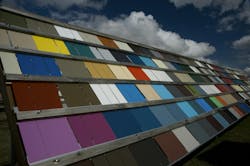Weather Testing Proves Critical for Durability of Exterior Coatings
The testing of coatings is an effective way to measure their exposure to sun, moisture and humidity, high temperatures, and temperature fluctuations, and the impact those exposures have on product performance. Companies choose to perform coatings tests for a myriad of reasons, some of which include assisting in new product development, improving quality and durability of current solutions, meeting customer requirements, and complying with government and environment regulations.
Exterior elements can cause degradation, resulting in the chalking or fading of coatings. To ensure its coatings can withstand nature’s destructive forces, Valspar uses diverse testing to measure these two types of degradation.
Chalking occurs when resin particles take on a powdery appearance due to the degradation of the resin system, resulting in imbedded pigment particles losing their adhesion to the film. Chalking is generally caused by exposure to UV light and can be detrimental when it is excessive, causing the lightening of paint colors; the erosion of the paint, which results in loss of protection; and the destruction of the underlying structure, which can deface the appearance of the coating surface.
Fading—or the loss of paint color caused by UV and hydrolytic degradation in the environment attacking the pigments in the coating.[1] Color fading is measured with “Delta E” values, a single number that represents the distance between two colors, a minimal detected difference is about 1 Delta E.
Fading is tested by ASTM D2244, which notes Delta E values. High-performance panels, such as Valspar’s Fluropon family of coatings, which are 70 percent PVDF coatings, must be tested for a minimum of 10 years, and color changes are measured on the exposed painting surface, which should be cleaned prior with water and a cloth. Values are then measured against the original retained panel, a control that is stored under stable conditions.[3]
Valspar’s test fence in Fort Myers, Fla., is the most accredited manufacturer’s test facility in the coil coatings industry. With more than 100,000 panels all facing south (generally at a 45-degree angle), coatings are exposed to key factors that contribute to degradation: high humidity, strong sun, and salt in the air. The site is an American Architectural Manufacturers Association (AAMA)-accredited full-service laboratory, meaning it adheres to specific ASTM International and AAMA test protocols.[4]
For quicker testing results, natural solar concentration devices are used for accelerated outdoor weather testing, ASTM G90.
QUV testing—one form of accelerated testing—takes place at Valspar’s global Applied Science and Technology lab, where coated panels are placed inside a QUV testing unit, exposing them to alternating cycles of UV light and moisture at controlled, elevated temperatures.
This type of testing is primarily used as a screen test in the coating development process. Certain types of resins, pigments, and other potential raw materials can be eliminated if they do not perform adequately. Accelerated testing takes less time to study than outdoor weather testing, but natural exposure provides the most unparalleled real-time results.
Performance tests are crucial for coating manufacturers and companies or firms that specify coatings, as the results provide a better understanding of how specific coatings react to natural exposure. When formulating new materials, this can in turn cut down the cycle time of development for the marketplace.
Measuring field performance can also deter and/or prolong color changes, chalking, blistering, and corrosion that threaten to degrade coatings. Durability testing is beneficial for providing architects, engineers, and contractors with viable results, proving that the coatings they are utilizing are durable and longer lasting—giving customers a peace of mind that their purchased coatings will not need to be replaced in the near future.
References
1 https://www.corrosionpedia.com/definition/2122/fading
2 https://www.astm.org/Standards/D4214.htm
3 http://weilandslidingdoors.com/wp-content/uploads/2012/05/weiland-aama-2605-05-kynar-500.pdf

